Fundamentos de Mecanica de Fluidos Munson Young Okiishi 6ed PDF

| Title | Fundamentos de Mecanica de Fluidos Munson Young Okiishi 6ed |
|---|---|
| Author | David Rivadeneira |
| Pages | 778 |
| File Size | 17 MB |
| File Type | |
| Total Downloads | 463 |
| Total Views | 706 |
Summary
JWCL068_fm_i-xxii.qxd 11/7/08 5:00 PM Page v Sixth Edition Fof undamentals Fluid Mechanics BRUCE R. MUNSON DONALD F. YOUNG Department of Aerospace Engineering and Engineering Mechanics THEODORE H. OKIISHI Department of Mechanical Engineering Iowa State University Ames, Iowa, USA WADE W. HUEBSCH Dep...
Description
JWCL068_fm_i-xxii.qxd
11/7/08
5:00 PM
Page v
Sixth Edition
undamentals Fof Fluid Mechanics BRUCE R. MUNSON DONALD F. YOUNG Department of Aerospace Engineering and Engineering Mechanics
THEODORE H. OKIISHI Department of Mechanical Engineering Iowa State University Ames, Iowa, USA
WADE W. HUEBSCH Department of Mechanical and Aerospace Engineering West Virginia University Morgantown, West Virginia, USA
John Wiley & Sons, Inc.
JWCL068_fm_i-xxii.qxd
11/11/08
2:30 PM
Page vi
To Erik and all others who possess the curiosity, patience, and desire to learn
Publisher: Don Fowley Editorial Assistant: Mark Owens Acquistions Editor: Jennifer Welter Media Editor: Lauren Sapira Marketing Manager: Christopher Ruel Production Manager: Dorothy Sinclair Production Editor: Sandra Dumas Senior Designer: Madelyn Lesure Production Management Services: Ingrao Associates/Suzanne Ingrao
Cover: photo shows the development of vortices which the water strider uses for moving on the surface of water by the transfer of momentum from the movement of its legs to the shed vortices (i.e. rowing). The fluid dynamics are visualized by adding thymol blue to the water surface. For more on water striders, see the following in this text: Problem 1.103 in Chapter 1; Fluids in the News titled “Walking on water” in Sect. 1.9; and Video V10.3 “Water strider” in Chapter 10. Photo courtesy of David L. Hu and John W. M. Bush, MIT. This book was typeset in 10/12 Times Roman by Aptara®, Inc., and printed and bound by R. R. Donnelley/Jefferson City. The cover was printed by R. R. Donnelley/Jefferson City. The paper in this book was manufactured by a mill whose forest management programs include sustained yield harvesting of its timberlands. Sustained yield harvesting principles ensure that the number of trees cut each year does not exceed the amount of new growth. This book is printed on acid-free paper. q
Copyright © 2009, 2006, 2002, 1999, 1994, 1990 by John Wiley & Sons, Inc. All rights reserved. No part of this publication may be reproduced, stored in a retrieval system or transmitted in any form or by any means, electronic, mechanical, photocopying, recording, scanning or otherwise, except as permitted under Sections 107 or 108 of the 1976 United States Copyright Act, without either the prior written permission of the Publisher or authorization through payment of the appropriate per-copy fee to the Copyright Clearance Center, 222 Rosewood Drive, Danvers, MA 01923, (978) 750-8400, fax (978) 646-8600. Requests to the Publisher for permission should be addressed to the Permission Department, John Wiley & Sons, Inc., 111 River Street, Hoboken, NJ 07030-5774, (201) 748-6011, fax (201) 748-6008. To order books or for customer service call 1-800-CALL-WILEY (225-5945). Munson, Bruce R., Young, Donald F., Okiishi, Theodore H., Huebsch, Wade W. Fundamentals of Fluid Mechanics, Sixth Edition ISBN 978-0470-26284-9 Printed in the United States of America. 10 9 8 7 6 5 4 3 2 1
JWCL068_fm_i-xxii.qxd
11/7/08
5:00 PM
Page vii
About the Authors Bruce R. Munson, Professor Emeritus of Engineering Mechanics at Iowa State University, received his B.S. and M.S. degrees from Purdue University and his Ph.D. degree from the Aerospace Engineering and Mechanics Department of the University of Minnesota in 1970. Prior to joining the Iowa State University faculty in 1974, Dr. Munson was on the mechanical engineering faculty of Duke University from 1970 to 1974. From 1964 to 1966, he worked as an engineer in the jet engine fuel control department of Bendix Aerospace Corporation, South Bend, Indiana. Dr. Munson’s main professional activity has been in the area of fluid mechanics education and research. He has been responsible for the development of many fluid mechanics courses for studies in civil engineering, mechanical engineering, engineering science, and agricultural engineering and is the recipient of an Iowa State University Superior Engineering Teacher Award and the Iowa State University Alumni Association Faculty Citation. He has authored and coauthored many theoretical and experimental technical papers on hydrodynamic stability, low Reynolds number flow, secondary flow, and the applications of viscous incompressible flow. He is a member of The American Society of Mechanical Engineers. Donald F. Young, Anson Marston Distinguished Professor Emeritus in Engineering, received his B.S. degree in mechanical engineering, his M.S. and Ph.D. degrees in theoretical and applied mechanics from Iowa State Uiversity, and has taught both undergraduate and graduate courses in fluid mechanics at Iowa State for many years. In addition to being named a Distinguished Professor in the College of Engineering, Dr. Young has also received the Standard Oil Foundation Outstanding Teacher Award and the Iowa State University Alumni Association Faculty Citation. He has been engaged in fluid mechanics research for more than 35 years, with special interests in similitude and modeling and the interdisciplinary field of biomedical fluid mechanics. Dr. Young has contributed to many technical publications and is the author or coauthor of two textbooks on applied mechanics. He is a Fellow of The American Society of Mechanical Engineers. Ted H. Okiishi, Professor Emeritus of Mechanical Engineering at Iowa State University, joined the faculty there in 1967 after receiving his undergraduate and graduate degrees from that institution. From 1965 to 1967, Dr. Okiishi served as a U.S. Army officer with duty assignments at the National Aeronautics and Space Administration Lewis Research Center, Cleveland, Ohio, where he participated in rocket nozzle heat transfer research, and at the Combined Intelligence Center, Saigon, Republic of South Vietnam, where he studied seasonal river flooding problems. Professor Okiishi and his students have been active in research on turbomachinery fluid dynamics. Some of these projects have involved significant collaboration with government and industrial laboratory researchers with two of their papers winning the ASME Melville Medal (in 1989 and 1998). Dr. Okiishi has received several awards for teaching. He has developed undergraduate and graduate courses in classical fluid dynamics as well as the fluid dynamics of turbomachines. He is a licensed professional engineer. His professional society activities include having been a vice president of The American Society of Mechanical Engineers (ASME) and of the American Society for Engineering Education. He is a Life Fellow of The American Society of Mechanical Engineers and past editor of its Journal of Turbomachinery. He was recently honored with the ASME R. Tom Sawyer Award. Wade W. Huebsch, Associate Professor in the Department of Mechanical and Aerospace Engineering at West Virginia University, received his B.S. degree in aerospace engineering from San Jose State University where he played college baseball. He received his M.S. degree in mechanical engineering and his Ph.D. in aerospace engineering from Iowa State University in 2000.
vii
JWCL068_fm_i-xxii.qxd
viii
11/7/08
5:00 PM
Page viii
About the Authors
Dr. Huebsch specializes in computational fluid dynamics research and has authored multiple journal articles in the areas of aircraft icing, roughness-induced flow phenomena, and boundary layer flow control. He has taught both undergraduate and graduate courses in fluid mechanics and has developed a new undergraduate course in computational fluid dynamics. He has received multiple teaching awards such as Outstanding Teacher and Teacher of the Year from the College of Engineering and Mineral Resources at WVU as well as the Ralph R. Teetor Educational Award from SAE. He was also named as the Young Researcher of the Year from WVU. He is a member of the American Institute of Aeronautics and Astronautics, the Sigma Xi research society, the Society of Automotive Engineers, and the American Society of Engineering Education.
JWCL068_fm_i-xxii.qxd
11/7/08
5:00 PM
Page ix
Preface This book is intended for junior and senior engineering students who are interested in learning some fundamental aspects of fluid mechanics. We developed this text to be used as a first course. The principles considered are classical and have been well-established for many years. However, fluid mechanics education has improved with experience in the classroom, and we have brought to bear in this book our own ideas about the teaching of this interesting and important subject. This sixth edition has been prepared after several years of experience by the authors using the previous editions for introductory courses in fluid mechanics. On the basis of this experience, along with suggestions from reviewers, colleagues, and students, we have made a number of changes in this edition. The changes (listed below, and indicated by the word New in descriptions in this preface) are made to clarify, update, and expand certain ideas and concepts.
New to This Edition In addition to the continual effort of updating the scope of the material presented and improving the presentation of all of the material, the following items are new to this edition. With the wide-spread use of new technologies involving the web, DVDs, digital cameras and the like, there is an increasing use and appreciation of the variety of visual tools available for learning. This fact has been addressed in the new edition by the inclusion of numerous new illustrations, graphs, photographs, and videos. Illustrations: The book contains more than 260 new illustrations and graphs. These illustrations range from simple ones that help illustrate a basic concept or equation to more complex ones that illustrate practical applications of fluid mechanics in our everyday lives. Photographs: The book contains more than 256 new photographs. Some photos involve situations that are so common to us that we probably never stop to realize how fluids are involved in them. Others involve new and novel situations that are still baffling to us. The photos are also used to help the reader better understand the basic concepts and examples discussed. Videos: The video library for the book has been significantly enhanced by the addition of 80 new video segments directly related to the text material. They illustrate many of the interesting and practical applications of real-world fluid phenomena. There are now 159 videos. Examples: All of the examples are newly outlined and carried out with the problem solving method of “Given, Find, Solution, and Comment.” Learning objectives: Each chapter begins with a set of learning objectives. This new feature provides the student with a brief preview of the topics covered in the chapter. List of equations: Each chapter ends with a new summary of the most important equations in the chapter. Problems: Approximately 30% new homework problems have been added for this edition. They are all newly grouped and identified according to topic. Typically, the first few problems in each group are relatively easy ones. In many groups of problems there are one or two new problems in which the student is asked to find a photograph/image of a particular flow situation and write a paragraph describing it. Each chapter contains new Life Long Learning Problems (i.e., one aspect of the life long learning as interpreted by the authors) that ask the student to obtain information about a given, new flow concept and to write a brief report about it. Fundamentals of Engineering Exam: A set of FE exam questions is newly available on the book web site.
ix
JWCL068_fm_i-xxii.qxd
x
11/7/08
5:00 PM
Page x
Preface
Key Features Illustrations, Photographs, and Videos y Fr < 1
Fr = 1 Fr > 1
E
Fluid mechanics has always been a “visual” subject—much can be learned by viewing various aspects of fluid flow. In this new edition we have made several changes to reflect the fact that with new advances in technology, this visual component is becoming easier to incorporate into the learning environment, for both access and delivery, and is an important component to the learning of fluid mechanics. Thus, approximately 516 new photographs and illustrations have been added to the book. Some of these are within the text material; some are used to enhance the example problems; and some are included as margin figures of the type shown in the left margin to more clearly illustrate various points discussed in the text. In addition, 80 new video segments have been added, bringing the total number of video segments to 159. These video segments illustrate many interesting and practical applications of real-world fluid phenomena. Many involve new CFD (computational fluid dynamics) material. Each video segment is identified at the appropriate location in the text material by a video icon and thumbnail photograph of the type shown in the left margin. Each video segment has a separate associated text description of what is shown in the video. There are approximately 160 homework problems that are directly related to the topics in the videos.
Examples V1.5 Floating Razor Blade
One of our aims is to represent fluid mechanics as it really is—an exciting and useful discipline. To this end, we include analyses of numerous everyday examples of fluid-flow phenomena to which students and faculty can easily relate. In the sixth edition 163 examples are presented that provide detailed solutions to a variety of problems. Many of the examples have been newly extended to illustrate what happens if one or more of the parameters is changed. This gives the user a better feel for some of the basic principles involved. In addition, many of the examples contain new photographs of the actual device or item involved in the example. Also, all of the examples are newly outlined and carried out with the problem solving methodology of “Given, Find, Solution, and Comment” as discussed on page 5 in the “Note to User” before Example 1.1.
Fluids in the News The set of approximately 60 short “Fluids in the News” stories has been newly updated to reflect some of the latest important, and novel ways that fluid mechanics affects our lives. Many of these problems have homework problems associated with them.
Homework Problems A set of more than 1330 homework problems (approximately 30% new to this edition) stresses the practical application of principles. The problems are newly grouped and identified according to topic. An effort has been made to include several new, easier problems at the start of each group. The following types of problems are included: 1) “standard” problems, 9) new “Life long learning” problems, 2) computer problems, 10) new problems that require the user to obtain 3) discussion problems, a photograph/image of a given flow situation and 4) supply-your-own-data problems, write a brief paragraph to describe it, 5) review problems with solutions, 11) simple CFD problems to be solved using 6) problems based on the “Fluids in the News” FlowLab, topics, 12) new Fundamental of Engineering (FE) exam 7) problems based on the fluid videos, questions available on book web site. 8) Excel-based lab problems, Lab Problems—There are 30 extended, laboratory-type problems that involve actual experimental data for simple experiments of the type that are often found in the laboratory portion of many introductory fluid mechanics courses. The data for these problems are provided in Excel format.
JWCL068_fm_i-xxii.qxd
11/7/08
5:00 PM
Page xi
Preface
xi
Life Long Learning Problems—There are more than 40 new life long learning problems that involve obtaining additional information about various new state-of-the-art fluid mechanics topics and writing a brief report about this material. Review Problems—There is a set of 186 review problems covering most of the main topics in the book. Complete, detailed solutions to these problems can be found in the Student Solution Manual and Study Guide for Fundamentals of Fluid Mechanics, by Munson, et al. (© 2009 John Wiley and Sons, Inc.).
Well-Paced Concept and Problem-Solving Development Since this is an introductory text, we have designed the presentation of material to allow for the gradual development of student confidence in fluid problem solving. Each important concept or notion is considered in terms of simple and easy-to-understand circumstances before more complicated features are introduced. Each page contains a brief summary (a highlight) sentence that serves to prepare or remind the reader about an important concept discussed on that page. Several brief components have been added to each chapter to help the user obtain the “big picture” idea of what key knowledge is to be gained from the chapter. A new brief Learning Objectives section is provided at the beginning of each chapter. It is helpful to read through this list prior to reading the chapter to gain a preview of the main concepts presented. Upon completion of the chapter, it is beneficial to look back at the original learning objectives to ensure that a satisfactory level of understanding has been acquired for each item. Additional reinforcement of these learning objectives is provided in the form of a Chapter Summary and Study Guide at the end of each chapter. In this section a brief summary of the key concepts and principles introduced in the chapter is included along with a listing of important terms with which the student should be familiar. These terms are highlighted in the text. A new list of the main equations in the chapter is included in the chapter summary.
System of Units Two systems of units continue to be used throughout most of the text: the International System of Units (newtons, kilograms, meters, and seconds) and the British Gravitational System (pounds, slugs, feet, and seconds). About one-half of the examples and homework problems are in each set of units. The English Engineering System (pounds, pounds mass, feet, and seconds) is used in the discussion of compressible flow in Chapter 11. This usage is standard practice for the topic.
Topical Organization In the first four chapters the student is made aware of some fundamental aspects of fluid motion, including important fluid properties, regimes of flow, pressure variations in fluids at rest and in motion, fluid kinematics, and methods of flow description and analysis. The Bernoulli equation is introduced in Chapter 3 to draw attention, early on, to some of the interesting effects of fluid motion on the distribution of pressure in a flow field. We believe that this timely consideration of elementary fluid dynamics increases student enthusiasm for the more complicated material that follows. In Chapter 4 we convey the essential elements of kinematics, including Eulerian and Lagrangian mathematical descriptions of flow phenomena, and indicate the vital relationship between the two views. For teachers who wish to consider kinematics in detail before the material on elementary fluid dynamics, Chapters 3 and 4 can be interchanged without loss of continuity. Chapters 5, 6, and 7 expand on the basic analysis methods generally used to solve or to begin solving fluid mechanics problems. Emphasis is placed on understanding how flow phenomena are described mathematically and on when and how to use infinitesimal and finite control volumes. The effects of fluid friction on pressure and velocity distributions are also considered in some detail. A formal course in thermodynamics is not required to understand the various portions of the text that consider some elementary aspects of the thermodynamics of fluid flow. Chapter 7 features the advantages of using dimensional analysis and similitude for organizing test data and for planning experiments an...
Similar Free PDFs

Crane Mecanica de fluidos
- 216 Pages

Mecanica de fluidos 1
- 232 Pages

Mecanica de fluidos - ejemplos
- 7 Pages

Ejercicios, Mecanica DE Fluidos
- 7 Pages

Solucionario de mecanica de fluidos
- 26 Pages

Mecanica de fluidos respuesas
- 4 Pages

Solucionario Mecanica de Fluidos
- 26 Pages

Mecanica de Fluidos
- 997 Pages

MECANICA DE FLUIDOS
- 124 Pages
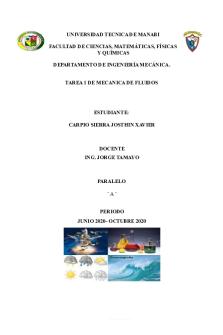
Resumen mecanica de fluidos
- 6 Pages
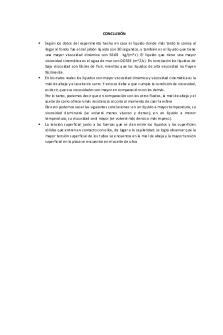
Conclusión mecanica de fluidos
- 1 Pages
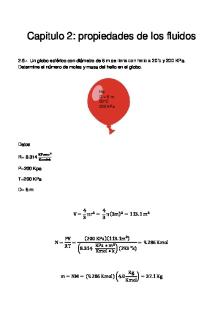
Mecanica de Fluidos Capitulo
- 7 Pages
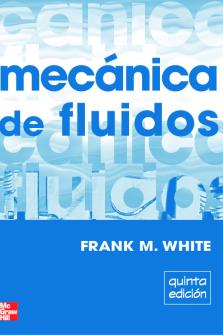
MECANICA DE FLUIDOS
- 850 Pages
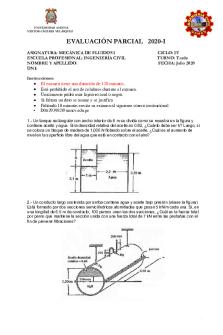
Examen mecanica de fluidos
- 2 Pages

Silabo Mecanica DE Fluidos
- 2 Pages
Popular Institutions
- Tinajero National High School - Annex
- Politeknik Caltex Riau
- Yokohama City University
- SGT University
- University of Al-Qadisiyah
- Divine Word College of Vigan
- Techniek College Rotterdam
- Universidade de Santiago
- Universiti Teknologi MARA Cawangan Johor Kampus Pasir Gudang
- Poltekkes Kemenkes Yogyakarta
- Baguio City National High School
- Colegio san marcos
- preparatoria uno
- Centro de Bachillerato Tecnológico Industrial y de Servicios No. 107
- Dalian Maritime University
- Quang Trung Secondary School
- Colegio Tecnológico en Informática
- Corporación Regional de Educación Superior
- Grupo CEDVA
- Dar Al Uloom University
- Centro de Estudios Preuniversitarios de la Universidad Nacional de Ingeniería
- 上智大学
- Aakash International School, Nuna Majara
- San Felipe Neri Catholic School
- Kang Chiao International School - New Taipei City
- Misamis Occidental National High School
- Institución Educativa Escuela Normal Juan Ladrilleros
- Kolehiyo ng Pantukan
- Batanes State College
- Instituto Continental
- Sekolah Menengah Kejuruan Kesehatan Kaltara (Tarakan)
- Colegio de La Inmaculada Concepcion - Cebu
